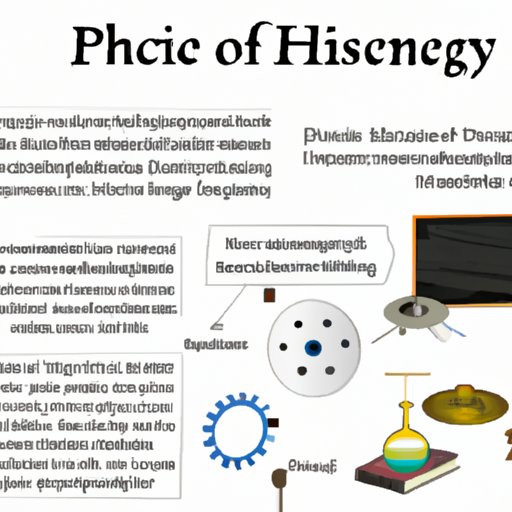
Overview of Physical Sciences: A Brief History and Introduction
The physical sciences are a broad field of scientific study that encompasses a wide range of disciplines. At its core, physical science is concerned with the behavior and properties of matter, energy, and their interactions. From astronomy and chemistry to geology and physics, the physical sciences have been at the forefront of scientific exploration for centuries.
A basic definition of physical science is “the branch of science that deals with the structure and behavior of matter and energy and the relationships among them.” This definition encompasses the various fields of study within the physical sciences, including astronomy, chemistry, earth science, and physics. All of these scientific disciplines are related in some way and involve the study of matter, energy, and their interactions.
History of Physical Sciences
The physical sciences have a long and rich history, stretching back to the earliest civilizations. Ancient Greeks were among the first to make significant contributions to the field, developing theories about the nature of matter, the universe, and the laws of physics. Over the centuries, the physical sciences have evolved and expanded, encompassing new discoveries and technologies.
In the modern era, the physical sciences have become increasingly interdisciplinary, as researchers from different fields collaborate to explore the mysteries of the natural world. From understanding the composition of the universe to exploring the inner workings of atoms, the physical sciences have played a vital role in advancing our knowledge of the world around us.

Key Concepts in Physical Sciences
At the heart of the physical sciences is the study of matter, energy, and their interactions. This involves studying the various properties of matter, such as density, heat, and pressure, as well as the behavior of energy, such as electricity and magnetism. Other key concepts in the physical sciences include thermodynamics, optics, and fluid dynamics.
These concepts are studied in order to gain an understanding of how the physical world works, and to develop new technologies. By understanding the basic principles of the physical sciences, researchers can apply this knowledge to solve real-world problems and create innovative solutions.
Types of Physical Sciences and Their Applications
The physical sciences encompass a number of different fields, each of which has its own unique focus and applications. Physics, for example, is the study of matter and energy and their interactions. It includes the study of motion, gravity, electricity, and magnetism, as well as the behavior of particles and waves.
Chemistry is another important field within the physical sciences. It is the study of the composition, structure, and properties of matter, as well as the reactions between different substances. Chemistry is used to understand the behavior of materials and to develop new materials and technologies.
Astronomy is the study of the universe and its objects, such as stars, planets, and galaxies. Astronomers use telescopes and other instruments to observe the sky and to study the origin and evolution of the universe.
Earth science is the study of the planet Earth, including its landforms, oceans, atmosphere, and climate. Geology is the study of the Earth’s structure and composition, as well as the processes that shape it. These fields are used to understand the Earth’s history and predict its future.
The physical sciences also have a variety of practical applications. For example, physics is used to develop new energy sources and medical technologies, while chemistry is used to develop new materials and medications. Astronomy is used to explore other planets and to search for extraterrestrial life, while geology is used to locate and extract natural resources.
Examining the Interconnectedness of Physical Sciences
The various fields of the physical sciences are interconnected in many ways. For example, the study of the Earth’s surface involves both geology and astronomy, as astronomers use observations of the night sky to measure changes in the Earth’s crust over time. Similarly, the study of climate change involves both geology and physics, as physicists study the behavior of the atmosphere and its interaction with the Earth’s surface.
The interconnectedness of the physical sciences has implications for research and technology development. By understanding the connections between different fields, scientists can develop more effective solutions to challenges facing humanity. Furthermore, the interconnectedness of the physical sciences allows for greater collaboration between researchers, enabling them to work together to solve complex problems.
Exploring the Impact of Physical Sciences on Society
The physical sciences have had a profound impact on society. Through the development of new technologies, the physical sciences have improved our lives in countless ways. From the invention of the light bulb to the discovery of antibiotics, the physical sciences have revolutionized the way we live.
The physical sciences have also had a major impact on our economy. New technologies developed through the physical sciences have created entire industries, such as the computer industry, and provided jobs for millions of people. Furthermore, the physical sciences have enabled us to explore and exploit new sources of energy, allowing us to power our homes and businesses.

Profiling Notable Scientists in Physical Sciences
Throughout history, there have been a number of notable scientists who have made significant contributions to the physical sciences. Isaac Newton, for example, is one of the most famous scientists of all time. He is credited with discovering the laws of motion and gravity, which laid the foundation for modern physics.
Albert Einstein is another renowned scientist whose work revolutionized the field of physics. His theory of relativity changed the way we think about time and space, and his theories of matter and energy continue to be studied today. Marie Curie is another notable scientist, best known for her work in the field of radioactivity.
These scientists and others have left a lasting legacy in the physical sciences. Their work has opened up new possibilities for exploration and discovery, and their influence can still be felt today. Their pioneering work has inspired generations of scientists to push the boundaries of knowledge and explore the mysteries of the physical world.
Conclusion
The physical sciences are a vast and diverse field of scientific study, encompassing a wide range of disciplines. From understanding the laws of physics to exploring the depths of the Earth’s oceans, the physical sciences have played a vital role in advancing our knowledge of the world around us. Furthermore, the physical sciences have had a profound impact on society, providing us with new technologies and creating entire industries. Finally, the physical sciences have been shaped by the contributions of notable scientists throughout history, whose work continues to inspire future generations of researchers.
(Note: Is this article not meeting your expectations? Do you have knowledge or insights to share? Unlock new opportunities and expand your reach by joining our authors team. Click Registration to join us and share your expertise with our readers.)
